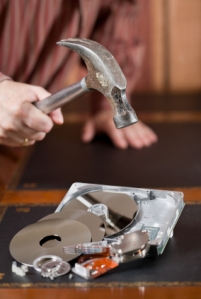How to Achieve Peace of Mind When Destroying Data Tapes
 It’s a data center administrator’s worst nightmare. A data tape headed for destruction disappears in transit. Even companies that use the very best tape management systems to track tapes and other media have no control once the media is in transit.
It’s a data center administrator’s worst nightmare. A data tape headed for destruction disappears in transit. Even companies that use the very best tape management systems to track tapes and other media have no control once the media is in transit.
And the fallout from such an incident can be very serious. Even if the data on the tape is never used for sinister purposes, the reputation of an organization can be irreparably harmed by the mishap.
Needless to say, bad things can happen to tapes when they leave the confines of the data center. In 2005, Bank of America lost a tape in transit containing personal information on 1.2 million federal employees. In 2007, the records of 64,000 state employees, 225,000 taxpayers and 84,000 welfare recipients disappeared when a tape was clipped from the back seat of an intern’s car in Ohio. In 2008, the University of Miami had a tape with 2.1 million patient records on it stolen from a storage company’s delivery van and Bristol Myers lost a tape with personal informationon an unspecified number of employees and their dependents when it was stolen from a delivery truck.
You get the picture.
When the time arrives to destroy old data tapes, a cautious organization may want to perform the task on-site. Tapes can be wiped through degaussing. However, it can be a time consuming and expensive process when done in-house. Moreover, not all tapes are the same. You need to use a strong enough magnetic field (especially for high density tapes) and proper exposure time for the type of tape. If the degaussing is not performed correctly, you risk the data on the tapes not being completely destroyed.
Data guillotines are an alternative that is a bit faster, but although they render tapes unusable, the remains still must be disposed of. Companies like Iron Mountain can pickup, completely destroy and environmentally dispose of tapes and other sensitive media, while providing full documentation.
One solution that’s gaining popularity is to outsource the destruction process to an outfit that makes house calls, such as companies like Shred Right and American Eagle Systems. These mobile destruction companies will destroy tapes on-site under the watchful eye of employees and video surveillance cameras. Their equipment can atomize several hundred tapes every four to five minutes and when they’ve completed their destructive duties, they’ll take away the waste for proper disposal. For large destruction projects, these companies can be a worthwhile alternative to in-house solutions.

